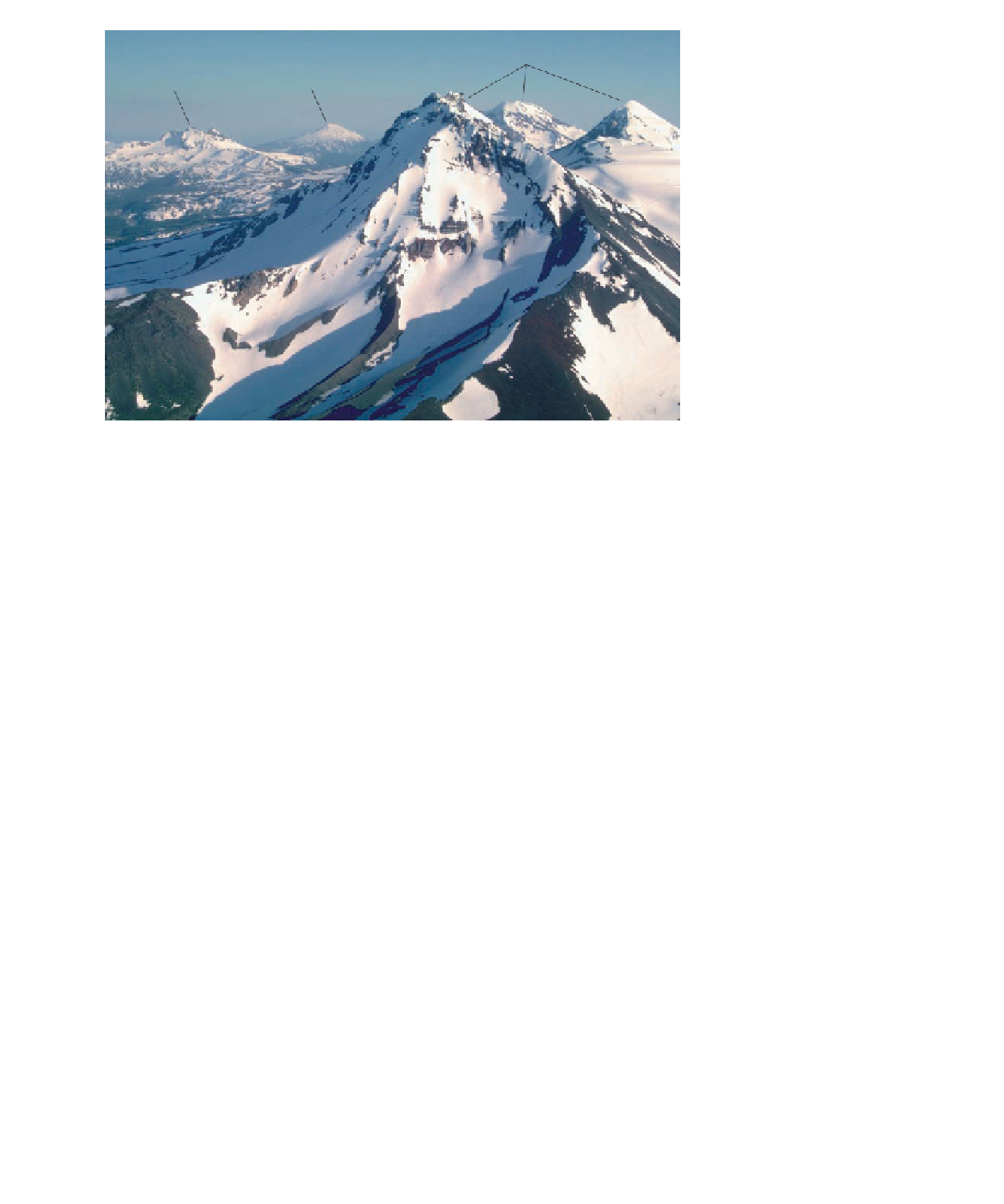Geology Reference
In-Depth Information
(
m
1
and
m
2
) is directly pro-
portional to the products of
their masses and inversely pro-
portional to the square of the
distance between their centers
of mass. This means that an
attractive force exists between
any two objects, and the mag-
nitude of that force varies de-
pending on the masses of the
objects and the distance be-
tween their centers. We gener-
ally refer to the gravitational
force between an object and
Earth as its
weight.
Gravitational attraction
would be the same everywhere
on the surface if Earth were per-
fectly spherical, homogeneous
throughout, and not rotating.
But because Earth varies in all of
these aspects, the force of gravity
varies from area to area. Geolo-
gists use a
gravimeter
to measure
gravitational attraction and to
detect
gravity anomalies
—
that is, departures from the expected force of gravity
(
Three Sisters
Mount Bachelor
Broken Top
◗
Figure 10.19
The Cascade Range The mountains of the Cascade Range are made up of volcanic
rocks, many of which formed during the last few million years. Lassen Peak in California erupted
from 1914 to 1917 and Mount St. Helens in Washington erupted in 1980 and 2004. This view
in Oregon shows three of the volcanoes in the range, which stretches from northern California
northward into British Columbia, Canada.
of seamounts, island arcs, and small pieces of continents that
were carried on oceanic plates that collided with continental
plates, thus adding them to the continental margins. We dis-
cuss this topic of terranes and their importance in mountain
building more fully in Chapter 22.
Figure 10.23). Gravity anomalies might be
positive
, meaning
that an excess of mass is present at some location, or
negative
,
when a mass defi ciency exists. For instance, a buried iron ore
deposit would yield a positive gravity anomaly because of the
greater density of these rocks.
Geologists realized long ago that mountains are not simply piles
of materials of Earth's surface, and in 1865 George Airy proposed
that, in addition to projecting high above sea level, mountains
also project far below the surface and thus have a low density
root (Figure 10.23). In effect, he was saying that the thicker crust
of mountains fl oat on denser rock at depth, with their excess
mass above sea level compensated for by low-density material
at depth. Another explanation was proposed by J. H. Pratt, who
thought that mountains were high because they were composed
of rocks of lower density than those in adjacent regions.
Actually, both Airy and Pratt were correct, because there
are places where density or thickness accounts for differences
in the level of the crust. For example, Pratt's hyphothesis
was confirmed because (1) continental crust is thicker and
less dense than oceanic crust and thus stands high, and (2)
the mid-oceanic ridges stand high because the crust there is
hot and less dense than cooler crust elsewhere. Airy, on the
other hand, was correct in his claim that the crust, continen-
tal or oceanic, “fl oats” on the mantle, which has a density of
3.3 g/cm
3
in its upper part. However, we have not yet explained
what we mean by one solid fl oating in another solid.
This phenomenon of Earth's crust floating in the
denser mantle is now known as the
principle of isostasy,
which is easy to understand by an analogy to an iceberg
◗
Continental crust stands higher than oceanic crust, but why
should this be so? Also, why do mountains stand higher
than surrounding areas? To answer these questions, we
must examine continental crust in more detail. You already
know that continental crust is granitic with an overall den-
sity of 2.7 g/cm
3
, whereas oceanic crust is made up of ba-
salt and gabbro and its density is 3.0 g/cm
3
. In most places,
continental crust is about 35 km thick except beneath moun-
tain systems, where it is much thicker. The oceanic crust, in
contrast, varies from only 5 to 10 km thick. So, these differ-
ences, as well as variations in crustal thickness, account for
why mountains stand high and why continents stand higher
than ocean basins (see the following section).
How is it possible for a solid (continental crust) to float in
another solid (the mantle)? Floating brings to mind a ship at
sea or a block of wood in water; however, continents do not
behave in this manner. Or do they? Actually, they do fl oat, in
a manner of speaking, but a complete answer requires more
discussion on the concept of gravity and on the principle of
isostasy.
Isaac Newton formulated the law of universal gravita-
tion in which the force of gravity (
F
) between two masses

Search WWH ::

Custom Search